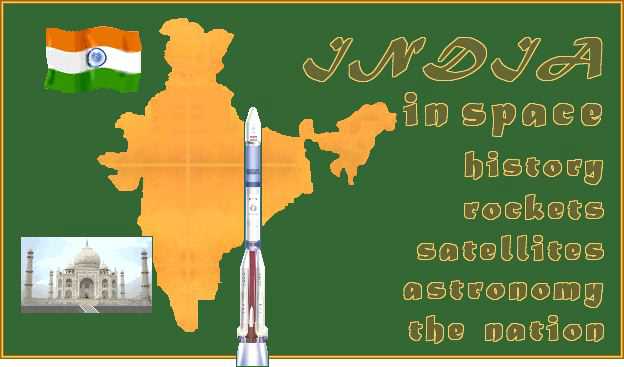

India's Space Satellites
Aryabhata, the first Indian space satellite, was launched for India on April 19, 1975.
ISRO image of Indian communication satellite
Later, Bhaskara-I, an Earth observation satellite, launched for India on June 7, 1979.
India launched its own satellite for the first time on July 18, 1980. It was the Rohini-1 satellite carried aloft on a Satellite Launch Vehicle (SLV) rocket from the Sriharikota Island launch site.
Since then, India has invested a great deal of its space development work in complex applications satellites. The nation's two main interests are satellites for remote sensing and communications -- used for weather pictures, disaster warnings and feeds to 552 television and 164 radio stations on the ground.
Space organizations. A Space Science & Technology Centre (SSTC) was established in 1965 in Thumba. A Satellite Telecommunication Earth Station was erected in 1967 at Ahmedabad. The Indian Space Research Organisation (ISRO) was created August 15, 1969, in the Department of Atomic Energy. Since then, ISRO has managed India's space research and the uses of space for peaceful puroposes.
The government established the Space Commission and the Department of Space (DOS) in June 1972. DOS conducts the nation's space activities for ISRO at four space centres across the country. DOS reports directly to the Prime Minister. ISRO was placed under DOS on June 1, 1972, and made a government organisation on April 1, 1975.
The first experimental launch from the Sriharikota Island launch site of a Satellite Launch Vehicle (SLV) rocket on August 10, 1979, did not place its Rohini Technology Payload satellite in orbit. However, the next year India successfully launched the Rohini-1 satellite on July 18, 1980, on a Satellite Launch Vehicle (SLV) rocket.
TV satellite. By the end of 1985, the Rohini-3 communications satellite launched in August 1983 had extended nationwide television coverage from 20 percent to 70 percent of the population. Today it is about 90 percent.
India's SROSS-1 satellite failed to achieve orbit when it rode the first developmental launch of an Augmented Satellite Launch Vehicle (ASLV) rocket on March 24, 1987. The second developmental launch of an ASLV in July 1988 also failed. Later, the third and fourth attempts were successful.
SROSS SROSS stands for Stretched Rohini Satellite Series. One of the satellites in the series, SROSS-C, was launched on an ASLV on May 20, 1992. It was India's first astrophysics observatory. The 235-lb. satellite had a gamma ray burst detector composed of high voltage scintillation detectors focused on the southern sky. Unfortunately, the satellite fell from orbit after only 55 days. Its replacement, SROSS-C2, was launched on May 4, 1994.
In 1992, the Indian-built INSAT-2 geostationary communications and meteorological satellite superseded an American-built INSAT-1.
Geosynchronous satellites. One of India's Geosynchronous Satellite Launch Vehicle (GSLV) rockets was blasted off on April 18, 2001, from the Sriharikota Island launch site in the southern state of Andhra Pradesh on the east coast of the nation near the Bay of Bengal. It placed a 1.5-ton experimental communications satellite called GSAT-1 into geosynchronous orbit 22,300 miles above Earth.
GSAT-1 was a communications satellite with digital audio, data and video broadcasting using two S-band, one high power C-band and two indigenous C-band transponders.
A GSLV rocket, similar in power to an American Delta rocket, can boost a large communications or weather satellite to a stationary orbit. India also plans to use GSLV rockets to send probes away from Earth to explore the planets. Missions to Mercury, Venus and Mars are under consideration.
India would like to use the GSLV launcher to tap into the global commercial launcher market.
PSLV launches TES. India's Technology Experiment Satellite (TES) was launched on October 22, 2001, aboard a Polar Satellite Launch Vehicle (PSLV-C3) from Sriharikota to a 350-mi.-high orbit.
ISRO image of India's Technology Experiment Satellite
The 2,440-lb. satellite tested new payload technologies, ranging from communications to remote sensing. It carried a panchromatic camera for Earth-imaging.
The satellite was monitored by ISRO's Spacecraft Control Centre (SCC) Telemetry Tracking and Command Network (ISTRAC) at Bangalore along with its small network of tracking stations at Lucknow, Mauritius, and Bearslake, Russia.
INSAT lofted by Ariane. The Indian National Satellite, INSAT-3C, designed and built by the Indian Space Research Organization (ISRO) was airlifted from Bangalore, India, to Cayenne Airport near Kourou, French Guyana in December 2001 in preparation for a launch on a European Space Agency Ariane-4 rocket on January 24, 2002.
INSAT-3C added much communications capacity to the INSAT fleet in orbit, including 24 C-band transponders, six extended C-band transponders, two S-band broadcast satellite service transponders and mobile satellite service transponders. The satellite beams commercial television signals to customers in India.
INSAT-3A launched in 2003. An Ariane 5 rocket carried the Indian-built satellite INSAT-3A to space from Kourou on April 9, 2003.
Insat 3A was built by the Indian Space Research Organization (ISRO) and carried a communications, weather imaging, and search-and-rescue payload.
The 3,000-lb. satellite measured about 9 by 6.5 by 6 ft. Its solar panels spanned about 43 ft.
Learn more:
Indian Space Research Organisation